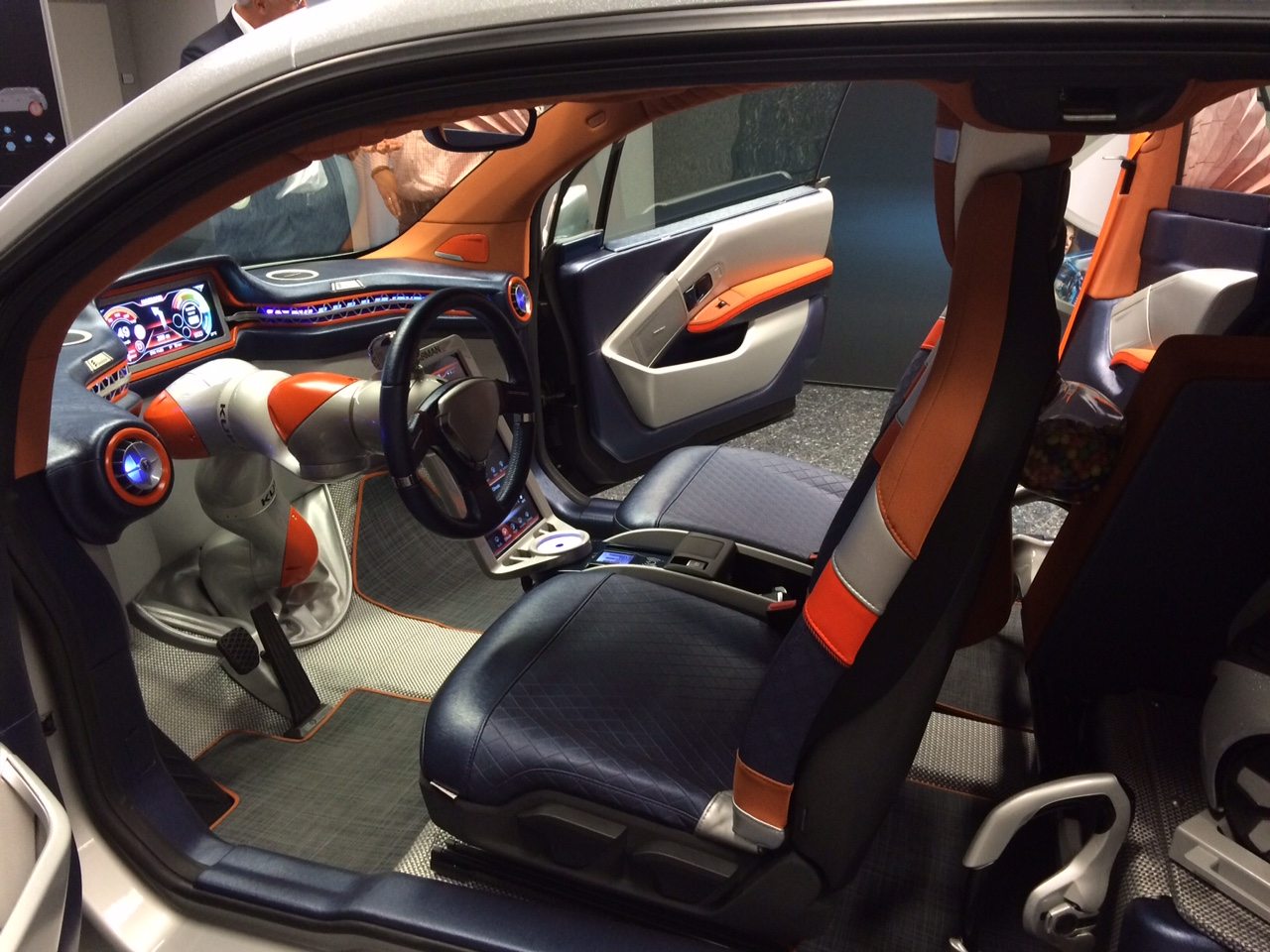I had the opportunity to attend Harman’s Technology Day late last week, with Budii the autonomous car as the event’s centerpiece.
The concept car program is led by Rinspeed, with Harman partnering as one of the participants. Unfortunately I didn’t get to go for a ride, but I did get to sit inside and see how the controls worked.
The human-machine interface of the autonomous vehicle concept is different from others primarily due to the use of a robotic arm, which controls the position of the steering wheel. If you want the car in full autonomous mode, the arm retracts, pulling the steering wheel out of the way and allowing for more space within the passenger compartment. Time for some traditional driving and the arm returns the steering wheel to standard driving position. What about the passenger taking a turn? Right-hand drive can also be enabled.
I guess the challenge I see with this concept is you are really kind of “on or off” and the idea of the human driving taking control in an emergency is no longer available if the steering wheel is retracted. Basically, this is truly a future vehicle in that sense. 
The journey begins by accessing the car via a smartphone, electronic key fob or wearable to identify who you are along with your preferred settings. It is possible to set everything in advance via a wearable or smartphone, so this doesn’t need to happen in the car. And if you purchase a new car, all of your information and settings can be instantly transferred. The displays in the vehicle are minimized in order to reduce driver distractions. By minimized, I don’t mean in size, but the amount of information offered to the driver in a single interface. Budii can also control your smart home to be configured as you like upon your arrival. 
Some of the vehicle-to-x functionality demonstrated had to do with integration to traffic lights. By maintaining an appropriate speed to have as many green lights as possible and keeping a consistent traffic flow; estimates predict fuel consumption could be reduced by up to 30%. A second scenario was related to emergency vehicles. When an emergency vehicle is approaching in the vicinity, the driver may or may not be aware and this could result in a dangerous situation; this is highlighted in the center console in order to increase awareness.
There are many sensors in cars today gathering information that aren’t really fully utilized. Think about a cloud-based service that could gather data from all of the vehicles on the road and provide road hazard situation awareness such as slippery conditions in the winter, rainstorms approaching, blinding sunshine and traffic patterns. A possibility for some creative company in the future I would think.
One of the topics currently being studied related to autonomous and semi-autonomous vehicles is if the lack of constant interaction will make the human driver sleepy. Ideas as to how to monitor this include steering wheel grip sensors and gaze tracking sensors to alert the car to move to a safe place off of the roadway and stop. Additionally, there are discussions regarding the ability for navigation systems to make driving safer in the interim through the elimination of specific driver actions, including:
- Reduce or eliminate routes that include left hand turns across oncoming traffic.
- Plotting the “safest” driving route in addition to today’s fastest and most direct routing options.
- Aggressive driver monitoring that would identify when a person is driving aggressively and route them along a calmer route.
Touch screens in cars are also a topic for safety. The larger the screens are, the farther away from you they tend to be due to engineering challenges. As people reach out to these screens, how do they know if they have made the correct selection and does this cause drivers to focus too intently on them? The integration of haptic feedback to make touch screens feel like actual buttons is a path being developed to resolve this challenge.
And my personal favorite; the use of infrared to track your touches. One outcome of this is not having to take your gloves off in the winter to use the touch screen, as depending on where you live you might not want to take your gloves off. This is already on the road in the new Volvo XC90.
Something I’d never really thought about with the impending autonomous functionality is how much drivers communicate with each other via eye contact – go ahead of me; cross the street; I’m not stopping, etc. If a human isn’t driving, what happens to this interaction in the future? You’ll notice the colorful light panels on the front and rear of the Bundii. I asked if they were just aesthetic, and it was explained there is some testing being done regarding the idea that different color displays could replace eye contact between drivers in the future to be “eye contact” between cars. Pretty cool idea. 
Well, let’s go for a ride!
Claudia Bacco, Managing Director – EMEA for RCR Wireless News, has spent her entire career the telecom, IT and security. Having experience at an operator, software and hardware vendors and as a well-known industry analyst, she has many opinions on the market. She’ll be sharing those opinions along with ongoing trend analysis for RCR Wireless News.
Like what you read? Follow me on twitter!



